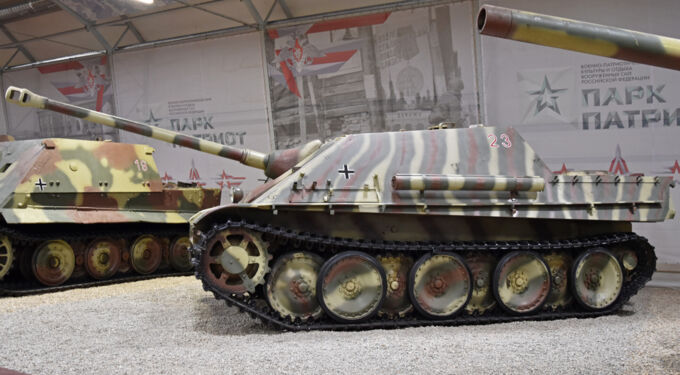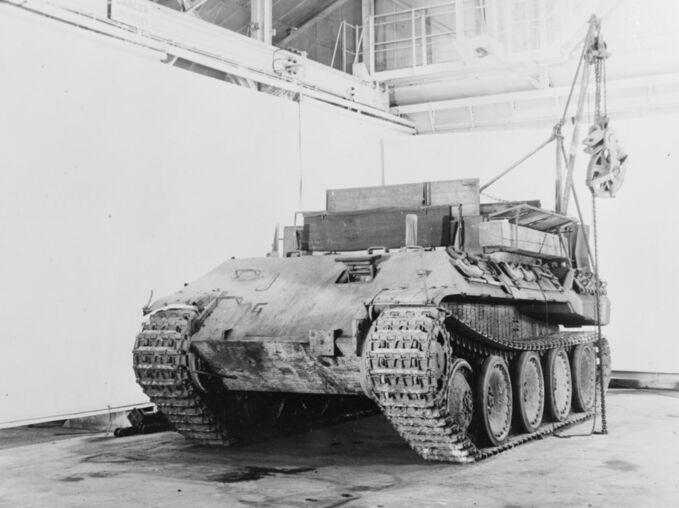The Panther, or Sd.Kfz.171, was a technical masterpiece of World War II, combining firepower, armor, and mobility in a way that surpassed many of its contemporaries. Designed as a response to the Soviet T-34, the Panther aimed to blend the maneuverability of a medium tank with the combat power of a heavy tank. At least 6,000 units were built from 1942 until the end of the war.
Development
The incentive for the development of the Panther was Operation Barbarossa, where the 5cm KwK on the Panzer III, which was intended for anti-tank defense, was no longer sufficient to penetrate the angled armor plates of the T-34. At this point in the war, the 75mm cannon of the Panzer IV was too immature and intended for infantry support, and German tank aces like Otto Carius and Generaloberst Heinz Guderian were demanding a new tank at that time.
In order to compete against Russian and British tanks, German tank crews demanded a tank with a powerful engine with enough horsepower to cope with the difficult terrain conditions of North Africa and Eastern Europe. In addition to optimal mobility, it should also have powerful armament. Above all, they demanded angled front armor, which the Panther delivered. However, the Panther had its shortcomings in the engine block, as this caught fire very easily. In order to counteract an engine fire, the Panther had its own extinguishing system in the engine compartment.
Early prototypes, such as the VK 30.02 (DB) by Daimler-Benz and the VK 30.02 (M) by MAN, laid the groundwork for the Panther’s development, with the VK 30.02 (M) ultimately chosen as the basis for the production model. The Panther saw its first action during the Battle of Kursk in 1943, where it demonstrated exceptional firepower and advanced optics but also revealed technical flaws, including engine fires and transmission failures.
Armed with the 7.5 cm KwK 42 L/70, the Panther was one of the most powerful tanks of its time. This gun could penetrate enemy armor at ranges of up to 2,000 meters, proving especially effective against the Soviet T-34 and KV-1 tanks. Supporting this was the advanced Zeiss SFL ZF 5 scope, enabling precise targeting at long distances. The Panther’s armor was another strength: the frontal armor was 80 mm thick and angled at 55°, significantly increasing its effective protection. However, its side armor, at 40–50 mm, was more vulnerable, making the Panther susceptible to flanking attacks.
Powered by a Maybach HL 230 P30 engine producing 700 horsepower, the Panther could reach a top speed of 46 km/h on roads. Its weight of 44.8 tons, however, made it cumbersome on soft terrain, and its high fuel consumption—700 liters per 100 kilometers off-road—posed logistical challenges. Its suspension system, featuring an interleaved road wheel design with 16 wheels per side, provided excellent cross-country performance but was maintenance-intensive and prone to issues in muddy or wintry conditions.
In the last months of the Second World War, engineers developed several improvements to the Panther series' components from April 1945, such as an automatic charging system, rubberless track rollers, improved optics, and a mine clearance attachment.
The Diversity of Variants
Beyond the standard variants like the Ausf D, A, G, Jagdpanther, and later F, several noteworthy special models were developed. The Panther II, an experimental design with enhanced armor and wider tracks, never progressed beyond the prototype stage.
Panther D
The Panther D is the first series variant of the Panther, which was produced according to the VK.30.02 (MAN). The D variant had the 7.5 cm KwK 42 L/70. It had an effective range of up to 1.3 km. The D variant also had two MG-34 machine guns and six smoke bombs on the sides of the turret.
Panther A
The A version of the Panther is almost identical to the D version, only the A version had a more powerful engine and was somewhat more heavily armored in critical areas. The smoke grenades were also removed and replaced by a mortar in the turret, which was also found in the G version. A third machine gun for the commander was also mounted on the hatch and a more advanced radio was also installed.
Panther G
The G variant had stronger armor in critical areas than the A variant, as can be seen from the gun mantlet, which was also partly carried over to later A models. The commander also had a third MG 34 on his command hatch.
Jagdpanther
The Jagdpanther was equipped with an 8.8 cm Pak 43/3 L/71 and was based on the improved Panther Ausf. G., which could produce 700 hp instead of 600 hp, but still had the same speed as the other Panther models and the same armor thickness, but this was more angled and therefore more difficult to penetrate.
Bergepanther
The Bergepanther was a recovery vehicle based on the Panther chassis. It had a powerful cable winch with a pulling force of 40 tons. For self-defense, it had either an MG 42 machine gun or a 2 cm Kampfwagen Kanone 30 with the respective gun mantlet mounted at the front.
PZ IV/V
One of the rarest and least-known designs was the PZ IV/V, a hybrid that mounted a Panzer IV F2, J, or H turret on a Bergepanther chassis. Such adaptations highlight the versatility of the Panther platform, which served as the foundation for numerous experimental designs.
The PZ IV/V was used by the Schwere-Panzerjäger Abteilung 653, among others, on the Eastern Front and in the late war on the Western Front; they used the PZ IV/V as a command tank.
Another conversion of a Panther was used by the Schwere-Panzerjäger Abteilung 653; it was a Panther chassis, but instead of a conventional turret, they used a 2 cm Flakvierling 38. The reason for such conversions were lack of resources; they used damaged tank chassis converted to such prototype tanks. As a product, the PZ IV/V is a rather unknown model.
Panther F
The Panther F is a later version of the Panther which was equipped with the “Schmalturm” (narrow turret), a less wide but taller type of turret which was equipped with a 7.5 cm KwK 44/1 L/70, a more powerful 7.5 cm cannon than the other Panther variants had up to that point. The Schmalturm also had a built-in rangefinder and an MG 42 and a StG 44 (Assault rifle 44/Sturmgewehr 44) also found space in the Panther F. Its armour could reach a thickness of up to 120 mm, which was usually this thick at the front. There were only a few prototypes of the Panther F including eight tank hulls and three turrets, two were built as prototypes.
Panther II
The Panther II was a prototype attempt at the late end of the Second World War to improve the Panther from scratch. The Panther II would get a “Schmalturm” (narrow turret) like the Panther F, but equipped with an 8.8 cm KwK 43 L/71 — the same as the Tiger II or the Ferdinand/Elefant. This also had two MG 34 in the chassis and one in the turret, and a FlaMG 34 (AA MG) on the commander’s cupola for protection against enemy aircraft.
The Panther II, at 3.10 m, was taller than the normal Panther which had a height of 2.99 m, and the weight of the Panther II was at least 50 tons. In comparison, the Panther G had a weight of 44.8 tons. This is due to the fact that the Panther II was highly armored with 120 mm front armour on the turret and hull, while other areas reached an armored thickness of at least 15 mm up to 100 mm. However, the Panther II had the same engine as the Panther G: a Maybach HL 230 P 30. This brought the Panther II 15 HP per ton and could make up to 46 km/h quickly. The single prototype is in the Patton Museum of Cavalry and Armor, Fort Knox.
The project was not completed due to the end of the war, which is why the Panther II did not progress beyond the prototype stage.
How German Tank Crews Found the Panther
Many German tank drivers found the Panther to be a useful tank, but they criticized its immature engine technology. Nevertheless, some veterans consider the Panther to be perhaps one of the best tanks of World War II. The British 17-pounder technology and the 85 mm and 122 mm Russian tanks were particularly serious opponents for the Panther crews. In general, every tank was taken very seriously, depending on the experience of the opposing tank commander. The Panther made a huge impression on the Allies and the Russians, but not as much as the Tiger I and II.
Panthers in Museums Around the World
Today, the Panther can be seen in several museums worldwide. A well-preserved Ausf. A is displayed at the Overloon War Museum in the Netherlands. Germany’s Panzermuseum Munster also houses a restored Panther, while the Musée des Blindés in Saumur, France, features a fully operational Panther. Additional examples can be found at the Bovington Tank Museum in England and the Kubinka Tank Museum in Russia. These tanks, considered milestones in armored vehicle development, showcase the technical ambitions of their era and the challenges of implementing such advanced designs. The Panther remains a fascinating example of World War II engineering and had a lasting influence on postwar tank designs.
Sources
- [The Online Tank Museum] Panzer V Panther Ausf.D, A, and G
- [Wikipedia DE] Panzerkampfwagen V Panther
- [Wikipedia DE] Bergepanther
- [Wikipedia DE] Jagdpanzer V Jagdpanther
- [Wikipedia DE] Panther II
- [Panther 1944] Die Entwicklung des Panzerkampfwagen V Panther
- [The Tank Museum] Panther
- [Musée de blindes] Panther
- [Wikipedia DE] Schwere Panzerjäger-Abteilung 653 # Trivia
- [Wikipedia DE] Panzerkampfwagen VK.30.02 (DB)
- [YouTube / Militär.Technik.Geschichte. — Jens Wehner] Was Panzermänner über die Panzertypen dachten? — mit Dr. Roman Töppel
- http://www.panther-panzer.de/PanzerV/PanzerVF.htm














